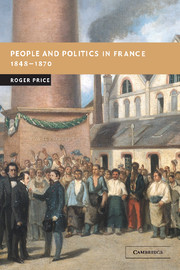Book contents
- Frontmatter
- Contents
- Acknowledgements
- List of abbreviations
- Introduction
- 1 Dominant classes: the social elites
- 2 Coming to terms with ‘democracy’
- 3 Aspiring social groups: the middle classes
- 4 Peasants and rural society: a dominated class?
- 5 Peasants and politics
- 6 The formation of a working class
- 7 The working-class challenge: socialisation and political choice
- Conclusion
- Select bibliography
- Index
4 - Peasants and rural society: a dominated class?
Published online by Cambridge University Press: 28 August 2009
- Frontmatter
- Contents
- Acknowledgements
- List of abbreviations
- Introduction
- 1 Dominant classes: the social elites
- 2 Coming to terms with ‘democracy’
- 3 Aspiring social groups: the middle classes
- 4 Peasants and rural society: a dominated class?
- 5 Peasants and politics
- 6 The formation of a working class
- 7 The working-class challenge: socialisation and political choice
- Conclusion
- Select bibliography
- Index
Summary
INTRODUCTION
The establishment of manhood suffrage in 1848 substantially enhanced the political importance of the rural population, which made up an estimated 74.5 per cent of the total in 1852. Probably around three-quarters of these people were engaged in farming. The figures are not very accurate but the number of men recorded as employed in agriculture was around 7,305,000 in 1856, rising to 7,995,000 by 1876. Contemporaries would have described the vast majority of them, rather loosely, as ‘peasants’. This would have included all those landowners who cultivated the soil with their own hands, tenant-farmers, sharecroppers, and agricultural labourers – most of whom aspired to own, and many of whom would succeed eventually in acquiring land through inheritance and/or purchase. Peasants could make or break a regime which sought legitimacy through the ballot box.
The basic methodological proposition which informs this study is that understanding political behaviour requires contextualisation. This demands a detailed analysis of peasant life. Historians and social anthropologists have frequently debated the value of the label ‘peasant’, however. The word is replete with notions of a cohesive, stable, and essentially autarkic community, subject to change only from external forces. The reductionism implicit in such binary configurations as commercial/subsistence, town/country, central power/local power is symptomatic. There is a tendency to overlook the constant need for rural populations to adapt to the natural environment, to demographic change, as well as to commercial opportunities and pressures.
- Type
- Chapter
- Information
- People and Politics in France, 1848–1870 , pp. 172 - 216Publisher: Cambridge University PressPrint publication year: 2004



